Abstract
During a 1-year period, three bacteriological systems for detecting bacteremia in children were analyzed, namely, the BACTEC system (Johnston Laboratories, Inc., Cockeysville, Md.), the Fisher/Lederle bottle (Lederle Diagnostics, Pearl River, N.Y.), and a direct plating method of blood termed quantitative direct plating (QDP). Of 2,123 blood cultures, 135 (6.4%) were positive; Haemophilus influenzae type b, Neisseria meningitidis, and Streptococcus pneumoniae accounted for 3.4%, representing 61 patients, other pathogens accounted for 0.6%, and contaminants accounted for 2.4%. Of 72 cultures yielding H. influenzae, N. meningitidis, and S. pneumoniae, 60 were recovered by both broth systems, 2 by BACTEC only and 10 by Fisher/Lederle bottle only. The BACTEC system failed to register a positive growth index reading by 24 h in 15 cultures which were positive for H. influenzae, even though growth had occurred, as shown by positive subculture and microscopy at this time. QDP detected 89% of the cultures positive for H. influenzae and N. meningitidis, of which 55% yielded results before either broth procedure. Only 50% of the cultures positive for S. pneumoniae yielded growth on QDP. This difference in the recovery rate probably is accounted for by the number of organisms in the blood. Thus, more than 100 organisms per ml of blood were found in 71% of cultures positive for H. influenzae and N. meningitidis but in only 7% of those positive for S. pneumoniae. These studies, then, have revealed that H. influenzae, which grew well in BACTEC broth, did not, however, give a significant growth index reading during day 1 of incubation, in contrast to N. meningitidis and S. pneumoniae. The QDP system not only provided information on the magnitude of bacteremia due to H. influenzae and N. meningitidis but frequently allowed earlier diagnosis and, thus, proved to be a valuable, simple, and inexpensive supplementary technique for broth cultures, although not for the diagnosis of S. pneumoniae bacteremia.
Full text
PDF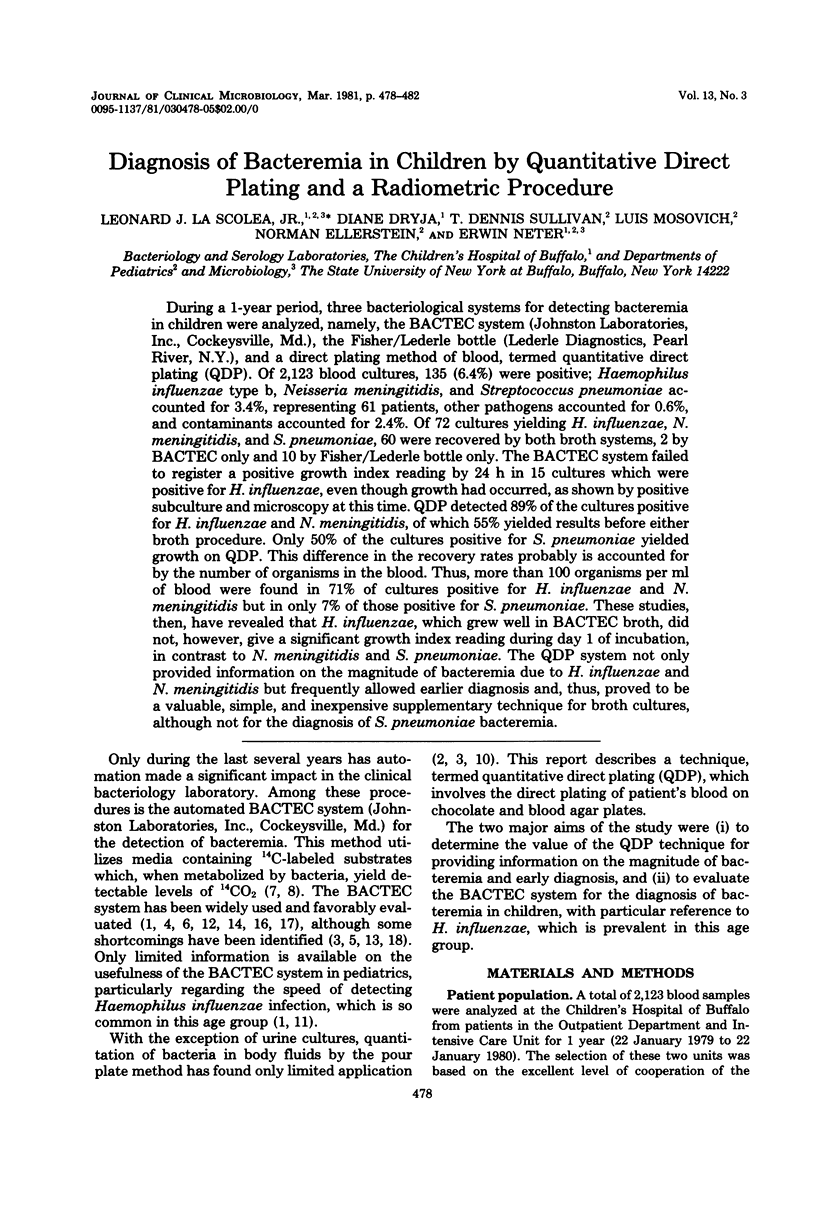
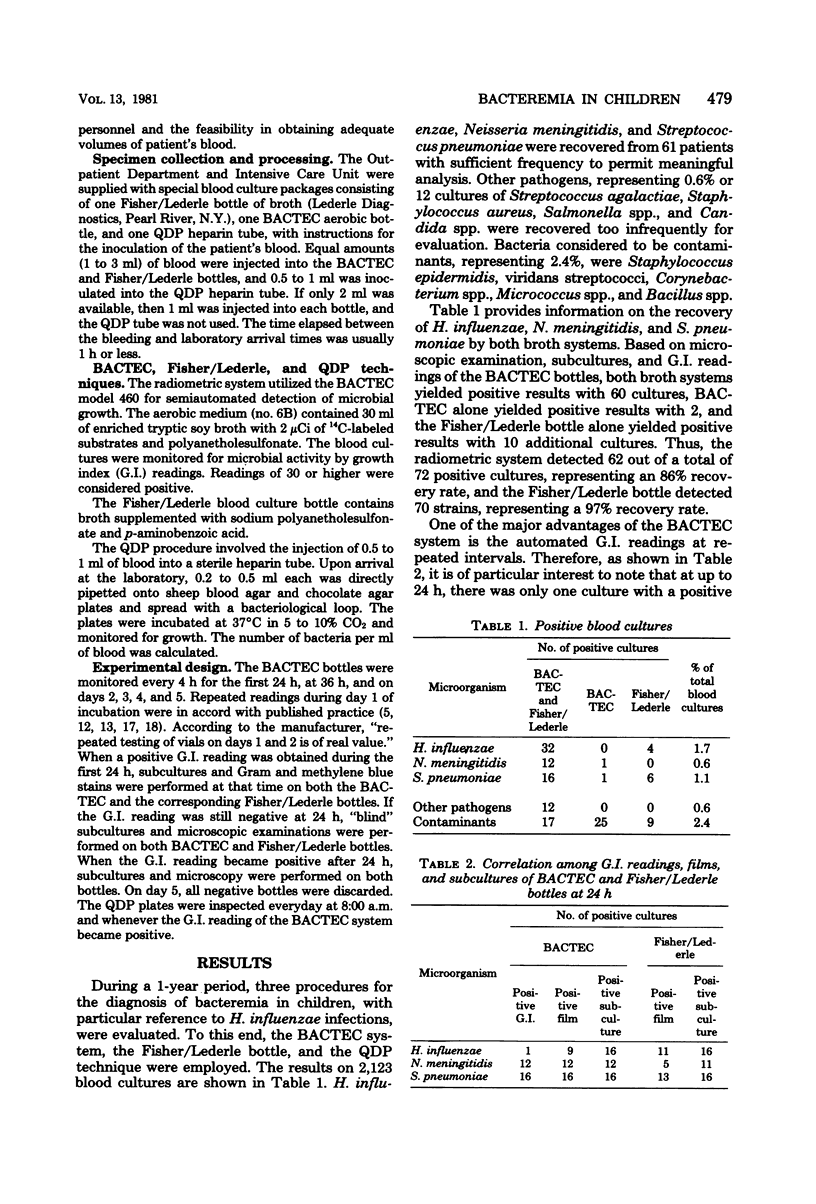
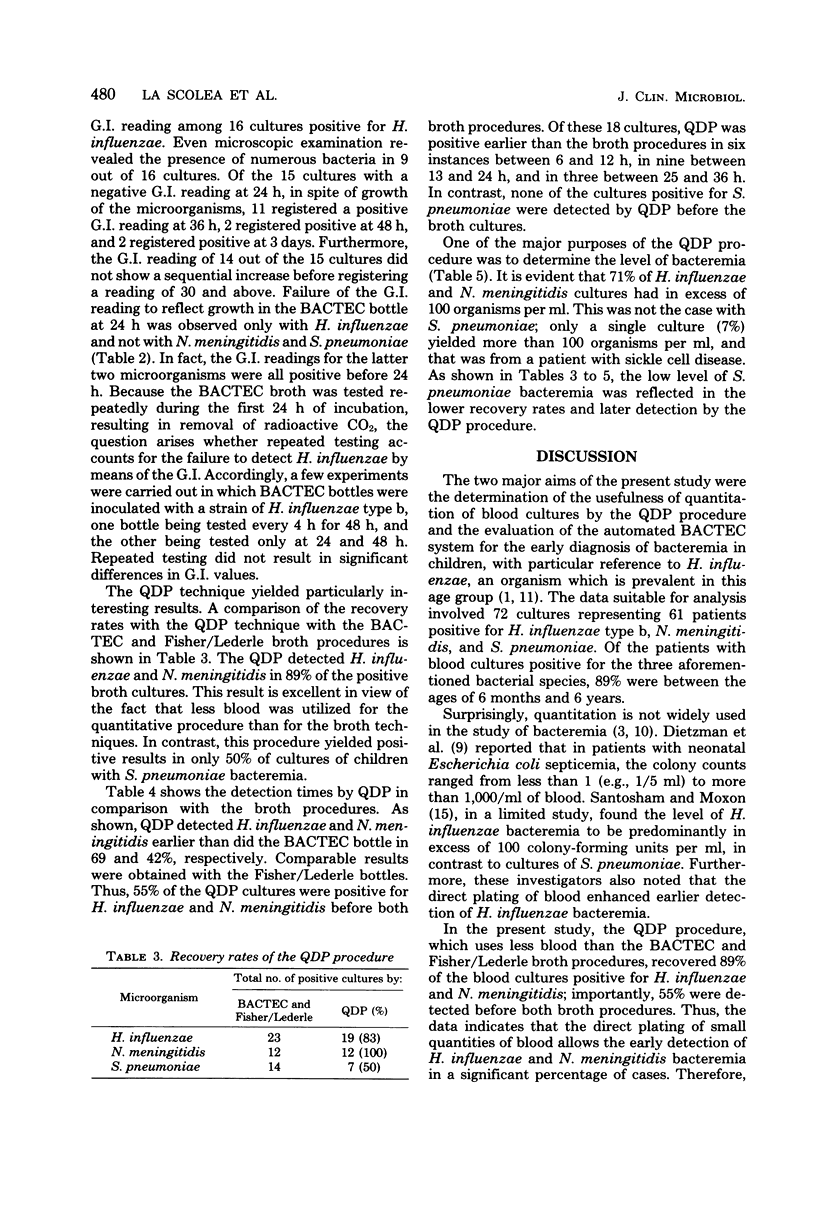
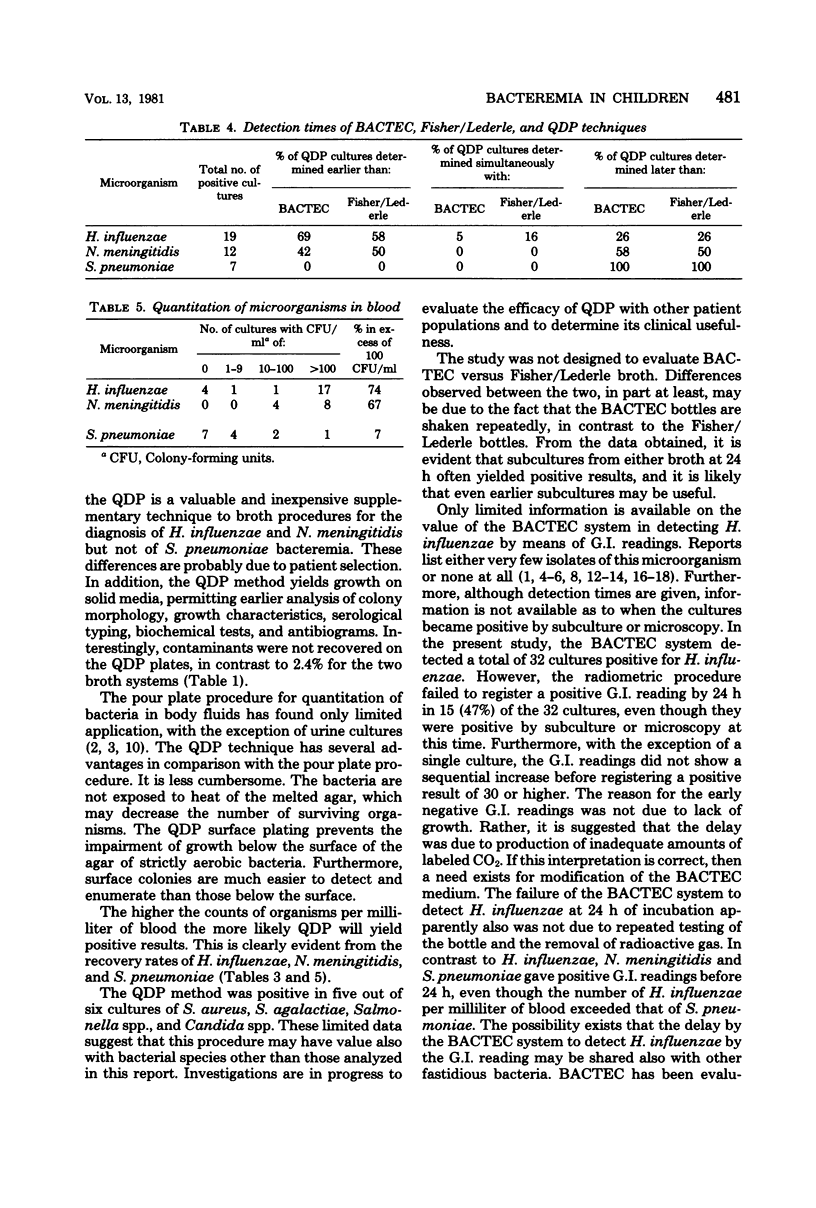
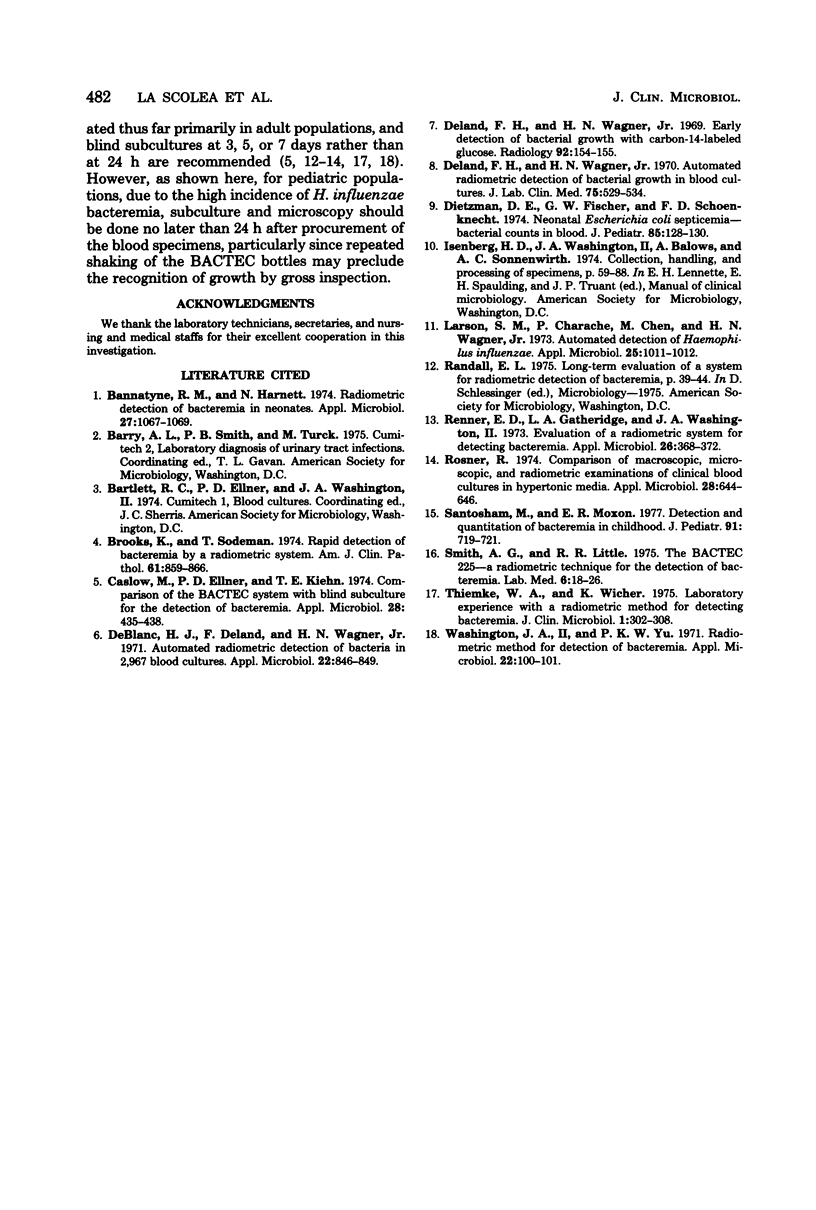
Selected References
These references are in PubMed. This may not be the complete list of references from this article.
- Bannatyne R. M., Harnett N. Radiometric detection of bacteremia in neonates. Appl Microbiol. 1974 Jun;27(6):1067–1069. doi: 10.1128/am.27.6.1067-1069.1974. [DOI] [PMC free article] [PubMed] [Google Scholar]
- Brooks K., Sodeman T. Rapid detection of bacteremia by a radiometric system. A clinical evaluation. Am J Clin Pathol. 1974 Jun;61(6):859–866. doi: 10.1093/ajcp/61.6.859. [DOI] [PubMed] [Google Scholar]
- Caslow M., Ellner P. D., Kiehn T. E. Comparison of the BACTEC system with blind subculture for the detection of bacteremia. Appl Microbiol. 1974 Sep;28(3):435–438. doi: 10.1128/am.28.3.435-438.1974. [DOI] [PMC free article] [PubMed] [Google Scholar]
- DeBlanc H. J., Jr, DeLand F., Wagner H. N., Jr Automated radiometric detection of bacteria in 2,967 blood cultures. Appl Microbiol. 1971 Nov;22(5):846–849. doi: 10.1128/am.22.5.846-849.1971. [DOI] [PMC free article] [PubMed] [Google Scholar]
- DeLand F. H., Wagner H. N., Jr Early detection of bacterial growth, with carbon-14-labeled glucose. Radiology. 1969 Jan;92(1):154–155. doi: 10.1148/92.1.154. [DOI] [PubMed] [Google Scholar]
- DeLand F., Wagner H. N., Jr Automated radiometric detection of bacterial growth in blood cultures. J Lab Clin Med. 1970 Mar;75(3):529–534. [PubMed] [Google Scholar]
- Dietzman D. E., Fischer G. W., Schoenknecht F. D. Neonatal Escherichia coli septicemia--bacterial counts in blood. J Pediatr. 1974 Jul;85(1):128–130. doi: 10.1016/s0022-3476(74)80308-2. [DOI] [PubMed] [Google Scholar]
- Larson S. M., Charache P., Chen M., Wagner H. N., Jr Automated detection of Haemophilus influenzae. Appl Microbiol. 1973 Jun;25(6):1011–1012. doi: 10.1128/am.25.6.1011-1012.1973. [DOI] [PMC free article] [PubMed] [Google Scholar]
- Renner E. D., Gatheridge L. A., Washington J. A., 2nd Evaluation of radiometric system for detecting bacteremia. Appl Microbiol. 1973 Sep;26(3):368–372. doi: 10.1128/am.26.3.368-372.1973. [DOI] [PMC free article] [PubMed] [Google Scholar]
- Rosner R. Comparison of macroscopic, microscopic, and radiometric examinations of clinical blood cultures in hypertonic media. Appl Microbiol. 1974 Oct;28(4):644–646. doi: 10.1128/am.28.4.644-646.1974. [DOI] [PMC free article] [PubMed] [Google Scholar]
- Santosham M., Moxon E. R. Detection and quantitation of bacteremia in childhood. J Pediatr. 1977 Nov;91(5):719–721. doi: 10.1016/s0022-3476(77)81022-6. [DOI] [PubMed] [Google Scholar]
- Thiemke W. A., Wicher K. Laboratory experience with a radiometric method for detecting bacteremia. J Clin Microbiol. 1975 Mar;1(3):302–308. doi: 10.1128/jcm.1.3.302-308.1975. [DOI] [PMC free article] [PubMed] [Google Scholar]
- Washington J. A., 2nd, Yu P. K. Radiometric method for detection of bacteremia. Appl Microbiol. 1971 Jul;22(1):100–101. doi: 10.1128/am.22.1.100-101.1971. [DOI] [PMC free article] [PubMed] [Google Scholar]


